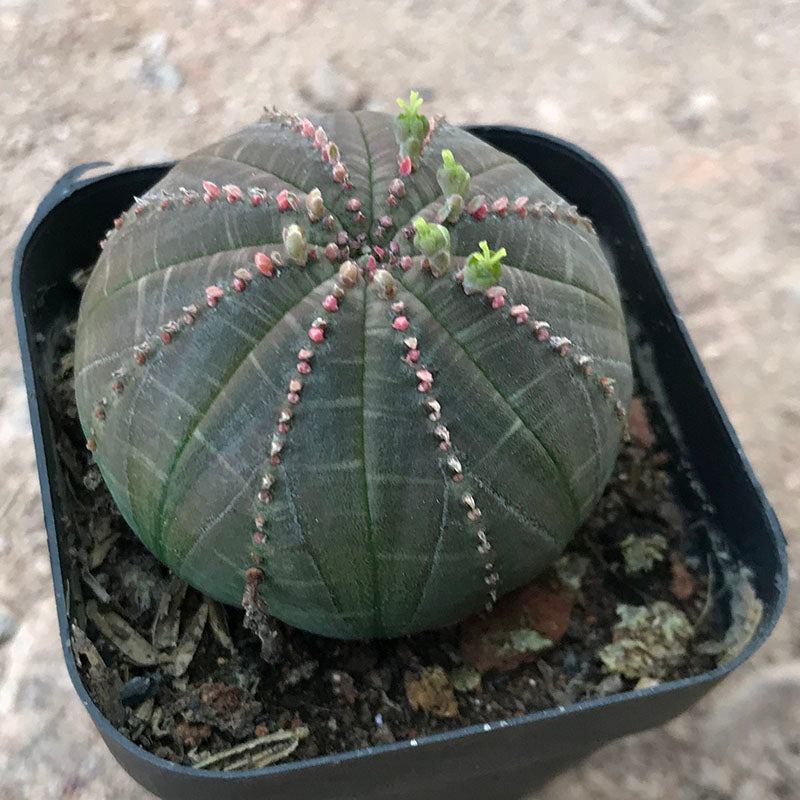Euphorbia obesa originated in the Cape Province of South Africa and belongs to the Crassulaceae family, genus Cotyledon, a succulent plant. The plant is spherical, with a diameter of 8-12 centimeters, and has ribs that are neat and orderly. The texture and color of the Euphorbia obesa's body are quite unique, which is why it is loved by many cactus enthusiasts.
When young, Euphorbia obesa is spherical, but later grows into a cylindrical shape, reaching a height of 30 centimeters and a diameter of 12 centimeters. The base of the sphere can produce offshoots, and the ribs tend to spiral. The flower stalks are woody and can persist at the top of the sphere for several years, possibly resulting from a natural cross between Euphorbia obesa and Cotyledon orbiculata. The skin is grayish-green with intersecting reddish-brown stripes, with denser stripes at the top. There are small brown blunt teeth along the edges of the ribs.
Light: Euphorbia obesa is a sun-loving succulent but is afraid of intense sunlight. Therefore, during spring, autumn, and winter, Euphorbia obesa can be exposed to full sunlight. In hot summers, shading should be provided as needed, along with good ventilation.
Temperature: Succulent Euphorbia obesa is not cold-resistant and prefers a warm environment. It is best to maintain a temperature of above 5°C in winter and keep the potting soil moderately dry. Low temperatures can easily cause frostbite and even death.
Watering: Like other succulents, Euphorbia obesa is quite drought-tolerant. Water thoroughly only when the soil is dry, avoiding watering when it's not necessary. During the growing season, water when the soil is dry, but avoid watering the leaves directly. Watering should be gradually increased in spring, paying attention to changes in weather.
Soil: Euphorbia obesa has low soil requirements and prefers well-draining sandy soil. A mixture of perlite, peat, vermiculite, and coal slag can be used, with a focus on good ventilation.
Propagation Method:
Euphorbia obesa can be propagated by seeds, but it's essential to pay attention to the pollination of male and female plants when flowering, collect seeds, and sow them in spring. Germination is relatively slow and requires patience.
Sowing:
Male and female flowers of Euphorbia obesa are not together, and the ratio is somewhat imbalanced, with fewer males usually. Therefore, it's challenging to naturally retain seeds during planting, and artificial control is necessary for pollination to ensure more fruit set and mature seeds. After maturation, the seeds will fall off on their own. Collect the seeds and select superior varieties for sowing. Generally, germination can occur in about half a month after sowing, and seedlings will gradually grow. Although Euphorbia obesa has been present in China for a long time, it is still rare because the probability of natural fruit set is relatively low. Therefore, if you want to retain seeds, you must pay attention to artificial pollination during planting.
Grafting:
Typically, Cotyledon is selected as the rootstock, and then the seedlings of Euphorbia obesa are cut as scions. After aligning the two incisions, hold them tightly by hand, then tie them tightly with a string. Generally, it takes about twenty days to heal, and Euphorbia obesa can then grow rapidly!
Other Notes:
Euphorbia obesa prefers a relatively dry and mild environment, likes sunlight, is not resistant to severe cold, and cannot withstand moisture invasion. During winter, attention should be paid to maintaining a temperature above 12°C.
The most suitable soil for growth is well-draining sandy soil. Good drainage is essential to prevent waterlogging and root rot.
Spring is the fastest growing season, so watering should be done appropriately. Try to keep Euphorbia obesa dry during summer and winter.
Every spring, repot the seedlings, adding some complete granular fertilizer to the soil.
Pay attention not to move the pot frequently to avoid damaging the sphere and prevent white leaf juice from flowing out of the wound, as this can cause the entire sphere to rot.
